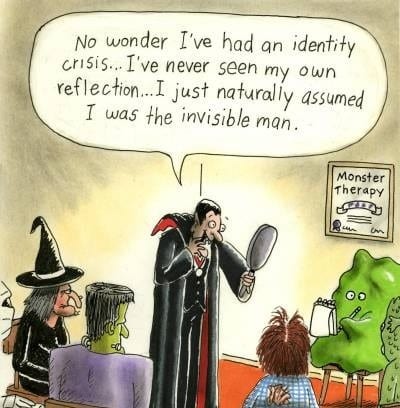March 20, 2019

If someone grows up not being recognized, acknowledged, understood or valued, do they exist? What about fictional character identity?
This thought occurred to me after seeing the musical play “Fun Home” earlier this year. One of the recurring lines was “chaos never happens if it’s never seen.” I made a note-to-self to write a story about a character whose identity was never seen … do they feel invisible or inconsequential? Do they believe they have agency? Are their actions and behaviors understandable?
If we as writers make the mistake of presenting our characters devoid of all the unacknowledged challenges that formed them, are we complicit in their flat ambiguity (or annihilation), by disregarding their essential identity?
In the prologue of Ralph Ellison’s novel “Invisible Man”, the narrator says “I am invisible, understand, simply because people refuse to see me.” Yet a person’s identity nevertheless serves as the invisible hand directing their life. And so in our fiction, if we haven’t fully understood our character’s DNA, their behaviors will seem hollow. This doesn’t mean we need to tell their entire life story, or even their upbringing (although in some cases we may allow it to be “discovered” bit-by-bit during the course of the story). However, it does mean that we need to know the nature of our character’s roots and upbringing when we construct the character. Their origins will drive what they do, how they do it, how they react, what their goals are, what obstacles they face in achieving their goals, and how – or whether – they overcome those obstacles.
For example, a character who has suffered multiple tragedies or traumas early in life, with no support from family, may defiantly brush off problems or threats as adults – at risk to their own well-being – and fail to seek support from others, being stubbornly independent. A character who grew up in a problem-free Ozzie & Harriet family where their every need was attended to, may not be able to deal with problems as an adult and become overly reliant on others to solve their challenges. Having an embedded understanding of our character’s origins will often nearly write our scenes for us! Those characters will take over our writing and do things we may not have planned in our story arc, because they want to achieve their own character arc, their actualization.
There are any number of “interview question” models out there to help us define our character, from the ridiculous to the sublime. 37 Questions – including such silliness as ‘Do you pick your nose?’, to over 100 questions. But the one I like gets to the heart of identity and motivation – from a Writer’s Digest interview of author Brenda Janowitz. It touches on what I find is essential for a protagonist – YEARNING – a la Robert Olen Butler.
Yearning – a character’s deepest desire (i.e., not just to catch the killer or solve the mystery) is driven by what was imbued in or missing from their early upbringing, or from subsequent phases of their life. It’s what drives character arc in our story. It’s what lies behind tension and conflict. It’s what achieves worthwhile plot resolution. As Butler says, “yearning, challenged and thwarted,” drives plot.
Yearning is what impels both the protagonist and the antagonist (each in different directions) in my novels. I’ll explore the implications of yearning further, in future posts.
How do you discover your character’s yearning?
How do their desires drive and evolve their behavior, and your story arc?